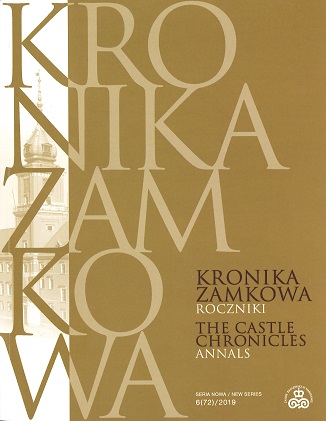Konstancja Austriaczka w kręgu świętych niewiast i władczyń. O pewnej królewskiej fundacji w katedrze krakowskiej.
Constance of Austria Among Saintly Womenand Rulers. On a Royal Foundation in Krakow Cathedral
Author(s): Krzysztof CzyżewskiSubject(s): Fine Arts / Performing Arts, History of Art
Published by: Arx Regia® Wydawnictwo Zamku Królewskiego w Warszawie – Muzeum
Keywords: House of Vasa; House of Habsburg; Constance of Austria; devotion to the Passion of Christ; Krakow Cathedral; royal foundations; crucifixes; St. Hedwig of Silesia; St. Bridget; St. Kinga;
Summary/Abstract: The article addresses the black tulle veil screening the Gothic crucifix from the late 14th century in the altar in the north-east corner of the Krakow Cathedral ambulatory. Popular literature and oral tradition linked the tulle veil with the national mourning following the defeat of the January Uprising. In reality, the veil was a gift of the second wife of Sigismund III, Constance of Austria, who made it by herself. This is indicated in the minutes of the Cathedral Chapter meetings of 28 June 1630 and the posthumous eulogy of the queen by Jan Lipski, published in 1633. The unique character of this foundation consists in the permanent veiling of the sculpture of the Crucified Jesus, displayed since 1634 against a background of a silver sheet in the altar donated by Canon Wojciech Serebryski. When the altar was founded, the silver sheet was also gilded. The donator fit the expectations concerning Christian rulers, who should provide for churches and donate paraments, preferably made by their own hand. At the same time, this was a token of the queen’s devotion to the Passion of Christ, which flourished during the period of introducing the reforms of the Council of Trent. In this respect, she followed in the footsteps of other women from the past and her contemporaries. The queen’s role models who most likely played an essential role in her spiritual development and might have inspired her gift to the Krakow Cathedral were: st. Hedwig Anjou (tradition has it that she talked to Christ represented on the crucifix), St. Hedwig of Silesia, st. Kinga, and St. Bridget of Sweden. All those holy women were depicted on the wings of the altar enclosing the image of the Crucified in the Krakow Cathedral. The dating of these paintings, not extant, is disputable; they may have been made in the Middle Ages or as late as in 1634. The Polish queen could be inspired by the innovative design of the Roman Basilica of St. Paul Outside the Walls, implemented in connection with the jubilee year 1600. An altar in the basilica featured a statue of St. Brigid and a crucifix which was said to have spoken to her (veiled on a daily basis). Another extensively debated issue is the custom of hiding miraculous crucifixes behind fabric curtains, particularly common in Spain and southern Italy. The case of the veiled Crucified Christ from the Augustinian monastery in Burgos (now in the local cathedral) seems to be particularly close to the crucifix at hand. The veils in Spain were removed in succession during solemn services, but the last translucent one was left screening the cross. Further studies might help to identify Queen Constance’s sources of inspiration for the tulle veil screening the image of the Redeemer in the Krakow Cathedral.
Journal: Kronika Zamkowa. Roczniki
- Issue Year: 6/2019
- Issue No: 6
- Page Range: 7-46
- Page Count: 40
- Language: Polish

